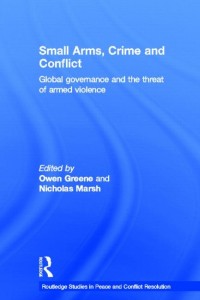|
Reviewed by Daveed Gartenstein-Ross, Ph.D. Candidate at the Catholic University of America Beyond this volume’s substantive look at key issues in the interrelationship between the availability of small arms and violence (a topic of keen interest to Africa specialists), it provides a fascinating look at this academic field’s transformation over the past two decades. Indeed, for researchers in emerging or rapidly changing fields, this book’s discussion of methodological leaps forward, and the occasionally counterintuitive answers that it spotlights, will be illuminating. The book contains important lessons in how early assumptions made within a field of study can be erroneous yet oft-repeated. The growth in the academic study of small arms and light weapons (SALW) has been considerable since the early 1990s. During that period, no more than a dozen researchers focused on the issue. Today, the field has grown “to several hundred plus many PhD students” (p. 3). In addition to numerical growth, the study of SALW has also experienced dramatic qualitative improvements. Editors Owen Greene and Nicholas Marsh write that in the early days, the field “sometimes suffered from partial and over-simplistic assumptions and perspectives” (p. 3). Thus, one significant theme in the book is the research of SALW itself, and how it has evolved. One persuasive conclusion that several contributors reach is the need for granularity when considering the linkage between the spread of SALW and conflict. As Mike Bourne’s chapter recounts, researchers tend to focus on large international arms transfers, which creates an “amorphous image” of “a vast stock of SALW circulating in a global-level illicit market, which is accessible to all conflict actors” (p. 29). But a growing body of research is challenging this conception. Bourne demonstrates at some length that in fact regional structures are critical, and that “many SALW flows to conflict occur purely at the regional level” (p. 33). Regional structures differ from the global structure in several important ways. Some chapters call into question well known statistics related to small arms and conflict that have been validated primarily through repetition. Joakim Kreutz and Nicholas Marsh examine the familiar estimate that 300,000 annual conflict deaths are attributable to SALW. Noting that there has never been “due explanation of the evidence” upon which this figure is based (p. 43), Kreutz and Marsh provide an accounting of when and where it first appeared. By tracing the statistic back to its first usages, they are able to unearth just how problematic it is. “Publications containing this estimate,” they note, “did not provide a detailed methodology and following up references where they have been provided leads just to estimates of total conflict mortality during the early 1990s without any disaggregation of what caused the deaths.” (pp. 43-44) Providing an exhaustive review of methodologies that can produce more precise figures, Kreutz and Marsh reasonably conclude that while “the original global death estimates served their purpose in mobilizing opinion” (p. 62), greater accuracy is now required. Readers who are especially interested in the Horn of Africa will surely take note of Valentina Bartolucci and Anna Betsy Kanneworff’s chapter on SALW availability and urban violence in Napoli, Italy, and Nairobi, Kenya. And one of the volume’s highlights is Owen Greene and Ariel Macaspac Penetrante’s contribution on non-state armed groups and state fragility, due to the manner in which the authors argue for their fascinating and counterintuitive thesis. Greene and Penetrante examine the Philippines as an extended case study, and conclude that-unsurprisingly-SALW availability has been “an important factor in the dynamics and reinforcement of state fragility in the Philippines” (p. 152). But when the authors examine whether the combination of SALW availability and partisan armed groups (PAGs) are driving the country toward state failure, their argument takes a turn for the surprising. They find that while there are indeed “malign synergies” between these factors, the Philippines has not entered into a spiral toward failure; and, in fact, “coping mechanisms” appear to have developed. There are in fact a variety of ways that SALW availability can affect state failure, including promoting state resilience in unexpected ways. For one thing, non-state armed groups are not necessarily anti-state; some of them may “support the political status quo” (p. 155). Further, while large numbers of localized PAGs promote human insecurity, they may also paradoxically promote political resilience. “It confines them to local violence, intimidation or security activities without capacities to challenge authorities at provincial or national levels,” the authors write. “Moreover, it is even possible that the prospect of armed resistance to a military coup by PAGs controlled by present governing elites helps to reduce any interventionist temptations within the national army.” The complex manner in which SALW availability functions as a feedback mechanism-weakening the state while in other ways perhaps reducing the likelihood of its ultimate failure-indicates that the causal impact one would intuit is not always correct, and also shows how an evolving field of research will sometimes reach surprising conclusions. This volume is a vital contribution for small arms researchers and Africanists interested in the role that SALW flows play in conflicts that they study. Beyond that, the book’s methodological discussions and portrayal of the transformation of a field of study should prove enlightening. |


 Small Arms, Crime and Conflict: Global Governance and the Threat of Armed Violence
Small Arms, Crime and Conflict: Global Governance and the Threat of Armed Violence